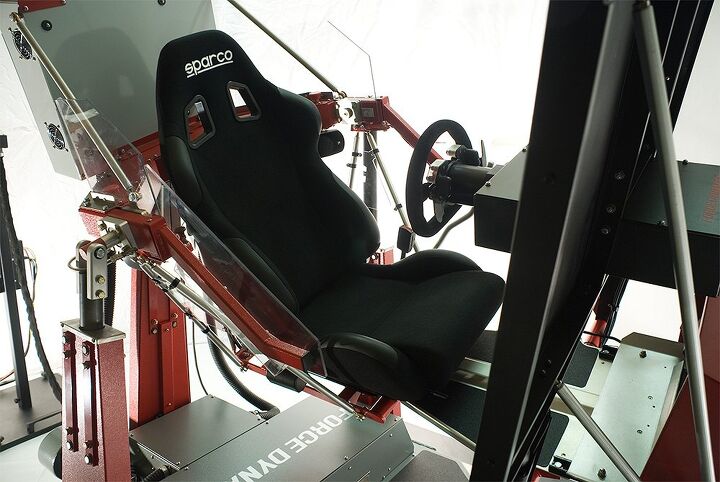TTAC Reader Pits Simulated MX-5 Against the Real Deal [with Video]
My company, Force Dynamics, builds full-motion driving simulators. They work by tilting you as the simulated vehicle corners or accelerates, so your brain is tricked into feeling lateral or longitudinal accelerations.
Sometimes people who watch our machines in action say, “This is moving way too much!” So when we started racing a Mazda Miata in the ChumpCar World Series, I decided to conduct an experiment.
The result: a comparison of the forces you feel while driving a race car with the forces you feel while driving our motion systems. The phone, like your inner ear, can’t tell the difference between being accelerated or tilted. What you see on the phone in each half of the video is what I was feeling in the real car and in the simulator.
How do the two experiences compare? Practicality limits the simulator’s sustained force to about .6 g. Luckily, your perception is enhanced a bit: in the simulator, the force keeping you in the seat gets lower as you tilt, whereas in real life that force is always 1 g, so you feel more “oomph” for a given load in the simulator than you do in real life. There’s also a psychological component. You’re seeing yourself cornering, and you’re getting other secondary cues, too: in the 401cr, your rate of rotation; vibration; sound and fury.
How do the two differ? Well, the real car is easier: your positional awareness is better, and the onset cues are sharper, so it’s easier to read the car on turn-in. Those differences aside, however, I was almost immediately comfortable making the transition to real driving. Shifting, braking, cornering, and handling the car on the limit all made nearly direct transitions to the track; for example, I was immediately comfortable holding the car at small slip angles through long, fast corners, because it behaved exactly like I expected it to.
What this means is while the simulator can’t fully match the sustained accelerations of a real car, the overall feel can be very good, and a high-quality motion platform can help immensely in the transition from simulator to track.
If you have any questions, feel free to ask in the comments.
Submitted by David Wiernicki. You may know him as B&B member PeriSoft in the comments.
More by Ur-Turn
Latest Car Reviews
Read moreLatest Product Reviews
Read moreRecent Comments
- Duke Woolworth Weight 4800# as I recall.
- Kwik_Shift_Pro4X '19 Nissan Frontier @78000 miles has been oil changes ( eng/ diffs/ tranny/ transfer). Still on original brakes and second set of tires.
- ChristianWimmer I have a 2018 Mercedes A250 with almost 80,000 km on the clock and a vintage ‘89 Mercedes 500SL R129 with almost 300,000 km.The A250 has had zero issues but the yearly servicing costs are typically expensive from this brand - as expected. Basic yearly service costs around 400 Euros whereas a more comprehensive servicing with new brake pads, spark plugs plus TÜV etc. is in the 1000+ Euro region.The 500SL servicing costs were expensive when it was serviced at a Benz dealer, but they won’t touch this classic anymore. I have it serviced by a mechanic from another Benz dealership who also owns an R129 300SL-24 and he’ll do basic maintenance on it for a mere 150 Euros. I only drive the 500SL about 2000 km a year so running costs are low although the fuel costs are insane here. The 500SL has had two previous owners with full service history. It’s been a reliable car according to the records. The roof folding mechanism needs so adjusting and oiling from time to time but that’s normal.
- Theflyersfan I wonder how many people recalled these after watching EuroCrash. There's someone one street over that has a similar yellow one of these, and you can tell he loves that car. It was just a tough sell - too expensive, way too heavy, zero passenger space, limited cargo bed, but for a chunk of the population, looked awesome. This was always meant to be a one and done car. Hopefully some are still running 20 years from now so we have a "remember when?" moment with them.
- Lorenzo A friend bought one of these new. Six months later he traded it in for a Chrysler PT Cruiser. He already had a 1998 Corvette, so I thought he just wanted more passenger space. It turned out someone broke into the SSR and stole $1500 of tools, without even breaking the lock. He figured nobody breaks into a PT Cruiser, but he had a custom trunk lock installed.


































Comments
Join the conversation
Two words: that is super cool.
Hey guys - I'm the guy from the article there (and the Chump in the car). If anyone has any questions, fire away! As for the ones already asked... yeah, it's more expensive than a Chump Car, though I have to say it's probably not THAT much more than all the costs of a few guys running Chump for a couple of years. As for pricing, think about a 5-series. Not the one with pleather and manual mirrors; the one you'd actually drive. So yeah, it's not super cheap. But like I said, if you take running costs into consideration, it starts to look reasonable again, especially if you're comparing it to something like running SCCA regionals: Good luck pulling that off (in most any class) for under fifty grand a year. And then there's the thing I tell people on YouTube: You can crash a simulator more than once!